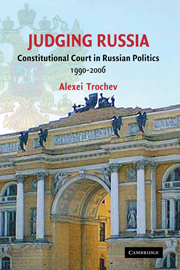Book contents
- Frontmatter
- Contents
- List of Figures and Tables
- Acknowledgments
- Abbreviations
- Notes on Transliteration
- 1 Introduction: Three Puzzles of Postcommunist Judicial Empowerment
- 2 Nonlinear Judicial Empowerment
- 3 Making and Remaking Constitutional Review, Russian-Style
- 4 Russian Constitutional Review in Action (1990–1993)
- 5 Decision Making of the 2nd Russian Constitutional Court: 1995–2006
- 6 The Constitutional Court Has Ruled – What Next?
- 7 The 2nd Russian Constitutional Court (1995–2007): Problematique of Implementation
- 8 “Tinkering with Judicial Tenure” and “Wars of Courts” in Comparative Perspective
- 9 Conclusion: Zigzagging Judicial Power
- Appendix
- Bibliography
- Statutes and Decrees
- Court Decisions
- Index
3 - Making and Remaking Constitutional Review, Russian-Style
Published online by Cambridge University Press: 25 July 2009
- Frontmatter
- Contents
- List of Figures and Tables
- Acknowledgments
- Abbreviations
- Notes on Transliteration
- 1 Introduction: Three Puzzles of Postcommunist Judicial Empowerment
- 2 Nonlinear Judicial Empowerment
- 3 Making and Remaking Constitutional Review, Russian-Style
- 4 Russian Constitutional Review in Action (1990–1993)
- 5 Decision Making of the 2nd Russian Constitutional Court: 1995–2006
- 6 The Constitutional Court Has Ruled – What Next?
- 7 The 2nd Russian Constitutional Court (1995–2007): Problematique of Implementation
- 8 “Tinkering with Judicial Tenure” and “Wars of Courts” in Comparative Perspective
- 9 Conclusion: Zigzagging Judicial Power
- Appendix
- Bibliography
- Statutes and Decrees
- Court Decisions
- Index
Summary
Institution-building during post-Soviet transformation has been likened to “rebuilding the ship at sea.” This metaphor, once qualified that the “sea” was stormy, could also describe well the politics of designing and setting up new constitutional courts in postcommunist Europe. Gigantic “waves” could be imagined as rapid and dramatic changes of constitutional frameworks prompted by the collapse of Communist Party rule, introduction of “true” parliamentary supremacy and later the office of the president, and power struggles over the destiny of the USSR. A “ship” caught in a tumultuous sea in need of repair was no less than a state itself, first – the USSR, and later – independent Russia. Rebuilding this “vessel” quickly to make it modern, democratic, capitalist, and law-based, was crucial for the survival of the state. The ship's “crew,” pro-Union elites, anti-Union elites in fifteen Soviet republics, and centripetal forces within the Russian Federation, was naturally divided: some argued for incremental repairs to stay afloat, others searched for radical measures to change the course of the drift; some looked for ways of saving the whole ship, others cared most for their own personal survival; some have found scapegoats and others claimed to have discovered the only correct way to salvation.
What is clear from this metaphor is that the short-time horizons of the “crew” (political elites) dominated post-Soviet state-building, which in itself is a long-term task.
- Type
- Chapter
- Information
- Judging RussiaThe Role of the Constitutional Court in Russian Politics 1990–2006, pp. 54 - 92Publisher: Cambridge University PressPrint publication year: 2008



